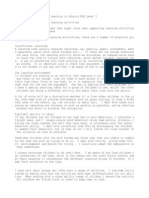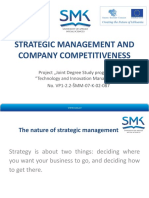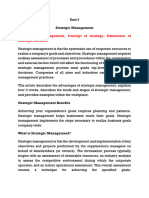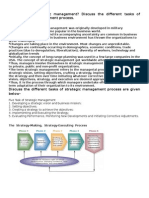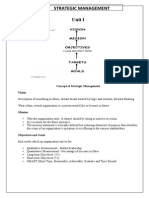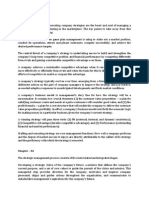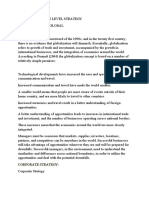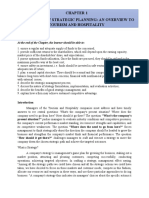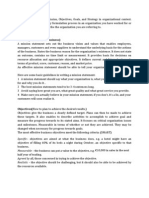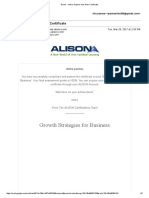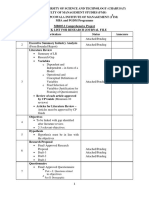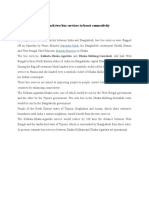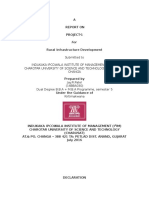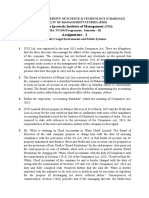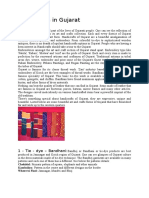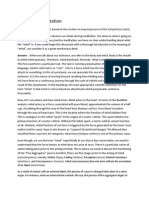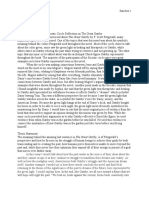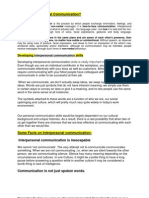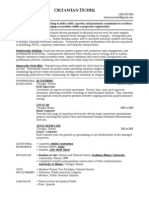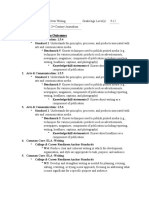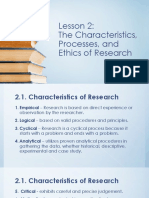Strategic Management Process - SMI
Strategic Management Process - SMI
Uploaded by
hardikgosaiCopyright:
Available Formats
Strategic Management Process - SMI
Strategic Management Process - SMI
Uploaded by
hardikgosaiOriginal Description:
Original Title
Copyright
Available Formats
Share this document
Did you find this document useful?
Is this content inappropriate?
Copyright:
Available Formats
Strategic Management Process - SMI
Strategic Management Process - SMI
Uploaded by
hardikgosaiCopyright:
Available Formats
10/10/2016
StrategicManagementProcess?|SMI
Home
Topics
Strategic Management Process
Strategic Management & Strategic Planning
Process
Ovidijus Jurevicius | February 13, 2013
Denition
Strategic management process is a method by which managers conceive of and
implement a strategy that can lead to a sustainable competitive advantage.[1]
Strategic planning process is a systematic or emerged way of performing strategic
planning in the organization through initial assessment, thorough analysis, strategy
formulation, its implementation and evaluation.
What is that strategic planning process?
The process of strategic management lists what steps the managers should take to
create a complete strategy and how to implement that strategy successfully in the
company. It might comprise from 7 to nearly 30 steps[4] and tends to be more formal in
well-established organizations.
The ways that strategies are created and realized dier. Thus, there are many dierent
models of the process. The models vary between companies depending upon:
Organizations culture.
Leadership style.
The experience the rm has in creating successful strategies.
All the examples of the process in this article represent top-down approach and belong
to the design school.
Components of strategic planning process
There are many components of the process which are spread throughout strategic
planning stages. Most often, the strategic planning process has 4 common phases:
https://www.strategicmanagementinsight.com/topics/strategicplanningprocess.html
[5]
1/10
10/10/2016
StrategicManagementProcess?|SMI
strategic analysis, strategy formulation, implementation and monitoring (David[5],
Johnson, Scholes & Whittington[6], Rothaermel[1], Thompson and Martin[2]). For clearer
understanding, this article represents 5 stages of strategic planning process:
Initial Assessment
Situation Analysis
Strategy Formulation
Strategy Implementation
Strategy Monitoring
Initial Assessment
Components: Vision statement & Mission statement
Tools used: Creating a Vision and Mission statements.
The starting point of the process is initial assessment of the rm. At this phase managers
must clearly identify the companys vision and mission statements.
Business' vision answers the question: What does an organization want to become?
Without visualizing the companys future, managers wouldnt know where they want to
go and what they have to achieve. Vision is the ultimate goal for the rm and the
direction for its employees.
In addition, mission describes companys business. It informs organizations stakeholders
about the products, customers, markets, values, concern for public image and employees
of the organization (David, p. 93)[5]. Thorough mission statement acts as guidance for
managers in making appropriate (Rothaermel, p. 34)[1] daily decisions.
Situation Analysis
Components: Internal environment analysis, External environment analysis and
Competitor analysis
Tools used: PEST, SWOT, Core Competencies, Critical Success Factors, Unique Selling
Proposition, Porter's 5 Forces, Competitor Prole Matrix, External Factor Evaluation
Matrix, Internal Factor Evaluation Matrix, Benchmarking, Financial Ratios, Scenarios
Forecasting, Market Segmentation, Value Chain Analysis, VRIO Framework
When the company identies its vision and mission it must assess its current situation in
the market. This includes evaluating an organizations external and internal environments
and analyzing its competitors.
https://www.strategicmanagementinsight.com/topics/strategicplanningprocess.html
2/10
10/10/2016
StrategicManagementProcess?|SMI
During an external environment analysis managers look into the key external forces:
macro & micro environments and competition. PEST or PESTEL frameworks represent all
the macro environment factors that inuence the organization in the global environment.
Micro environment aects the company in its industry. It is analyzed using Porters 5
Forces Framework.
Competition is another uncontrollable external force that inuences the company. A
good example of this was when Apple released its IPod and shook the mp3 players
industry, including its leading performer Sony. Firms assess their competitors using
competitors prole matrix and benchmarking to evaluate their strengths, weaknesses
and level of performance.
Internal analysis includes the assessment of the companys resources, core competencies
and activities. An organization holds both tangible resources: capital, land, equipment,
and intangible resources: culture, brand equity, knowledge, patents, copyrights and
trademarks (Rothaermel, p. 90)[1]. A rms core competencies may be superior skills in
customer relationship or ecient supply chain management. When analyzing the
companys activities managers look into the value chain and the whole production
process.
As a result, situation analysis identies strengths, weaknesses, opportunities and threats
for the organization and reveals a clear picture of companys situation in the market.
Strategy Formulation
Components: Objectives, Business level, Corporate level and Global Strategy Selection
Tools used: Scenario Planning, SPACE Matrix, Boston Consulting Group Matrix, GEMcKinsey Matrix, Porters Generic Strategies, Bowmans Strategy Clock, Porters
Diamond, Game Theory, QSP Matrix.
Successful situation analysis is followed by creation of long-term objectives. Long-term
objectives indicate goals that could improve the companys competitive position in the
long run. They act as directions for specic strategy selection. In an organization,
strategies are chosen at 3 dierent levels:
Business level strategy. This type of strategy is used when strategic business units
(SBU), divisions or small and medium enterprises select strategies for only one
product that is sold in only one market. The example of business level strategy is well
illustrated by Royal Eneld rms. They sell their Bullet motorcycle (one product) in
United Kingdom and India (dierent markets) but focus on dierent market
segments and sell at very dierent prices (dierent strategies). Firms may select
between Porters 3 generic strategies: cost leadership, dierentiation and focus
https://www.strategicmanagementinsight.com/topics/strategicplanningprocess.html
3/10
10/10/2016
StrategicManagementProcess?|SMI
strategies. Alternatively strategies from Bowmans strategy clock may be chosen
(Johnson, Scholes, & Whittington, p. 224[6]).
Corporate level strategy. At this level, executives at top parent companies choose
which products to sell, which market to enter and whether to acquire a competitor or
merge with it. They select between integration, intensive, diversication and
defensive strategies.
Global/International strategy. The main questions to answer: Which new markets to
develop and how to enter them? How far to diversify? (Thompson and Martin, p.
557[2], Johnson, Scholes, & Whittington, p. 294[6])
Managers may choose between many strategic alternatives. That depends on a
companys objectives, results of situation analysis and the level for which the strategy is
selected.
Strategy Implementation
Components: Annual Objectives, Policies, Resource Allocation, Change Management,
Organizational chart, Linking Performance and Reward
Tools used: Policies, Motivation, Resistance management, Leadership, Stakeholder
Impact Analysis, Changing organizational structure, Performance management
Even the best strategic plans must be implemented and only well executed strategies
create competitive advantage for a company.
At this stage managerial skills are more important than using analysis. Communication in
strategy implementation is essential as new strategies must get support all over
organization for eective implementation. The example of the strategy implementation
that is used here is taken from Davids book, chapter 7 on implementation[5]. It consists of
the following 6 steps:
Setting annual objectives;
Revising policies to meet the objectives;
Allocating resources to strategically important areas;
Changing organizational structure to meet new strategy;
Managing resistance to change;
Introducing new reward system for performance results if needed.
The rst point in strategy implementation is setting annual objectives for the companys
functional areas. These smaller objectives are specically designed to achieve nancial,
marketing, operations, human resources and other functional goals. To meet these goals
managers revise existing policies and introduce new ones which act as the directions for
successful objectives implementation.
https://www.strategicmanagementinsight.com/topics/strategicplanningprocess.html
4/10
10/10/2016
StrategicManagementProcess?|SMI
The other very important part of strategy implementation is changing an organizational
chart. For example, a product diversication strategy may require new SBU to be
incorporated into the existing organizational chart. Or market development strategy may
require an additional division to be added to the company. Every new strategy changes
the organizational structure and requires reallocation of resources. It also redistributes
responsibilities and powers between managers. Managers may be moved from one
functional area to another or asked to manage a new team. This creates resistance to
change, which has to be managed in an appropriate way or it could ruin excellent
strategy implementation.
Strategy Monitoring
Components: Internal and External Factors Review, Measuring Companys
Performance
Tools used: Strategy Evaluation Framework, Balanced Scorecard, Benchmarking
Implementation must be monitored to be successful. Due to constantly changing
external and internal conditions managers must continuously review both environments
as new strengths, weaknesses, opportunities and threats may arise. If new circumstances
aect the company, managers must take corrective actions as soon as possible.
Usually, tactics rather than strategies are changed to meet the new conditions, unless
rms are faced with such severe external changes as the 2007 credit crunch.
Measuring performance is another important activity in strategy monitoring.
Performance has to be measurable and comparable. Managers have to compare their
actual results with estimated results and see if they are successful in achieving their
objectives. If objectives are not met managers should:
Change the reward system.
Introduce new or revise existing policies.
The key element in strategy monitoring is to get the relevant and timely information on
changing environment and the companys performance and if necessary take corrective
actions.
Dierent models of the process
There is no universal model of the strategic management process. The one, which was
described in this article, is just one more version of so many models that are established
by other authors. In this section we will illustrate and comment on 3 more well-known
https://www.strategicmanagementinsight.com/topics/strategicplanningprocess.html
5/10
10/10/2016
StrategicManagementProcess?|SMI
frameworks presented by recognized scholars in the strategic management eld. More
about these models can be found in the authors books.
Figure 1. Davids Model of the Strategic Managements Process
ModeloftheStrategicManagementProcess
External
Environment
Analysis
DevelopVision
andMission
Statements
Establish
LongTerm
Objectives
Generate,
Evaluate,and
Choose
Strategies
Implement
Strategies
Measureand
Evaluate
Performance
Internal
Environment
Analysis
StrategyFormulation
Strategy
Implementation
Strategy
Evaluation
Source: David (p. 46)
Stages
Strategy Formulation
Strategy Implementation
Strategy Evaluation
Steps
1. Develop vision and mission
2. External environment analysis
3. Internal environment analysis
4. Establish long-term objectives
5. Generate, evaluate and choose strategies
6. Implement strategies
7. Measure and evaluate performance
Benets
Indicates all the major steps that have to be met during the process.
https://www.strategicmanagementinsight.com/topics/strategicplanningprocess.html
6/10
10/10/2016
StrategicManagementProcess?|SMI
Illustrates that the process is a continuous activity.
Arrows show the two way process. This means that companies may sometimes go a
step or two back in the process rather than having to complete the process and start
it all over from the beginning. For example, if in the implementation stage the
company nds out that the strategy it chose is not viable, it can simply go back to the
strategy selection point instead of continuing to the monitoring stage and starting
the process from the beginning.
Drawbacks
Represents only strategy formulation stage and does separate situation analysis from
strategy selection stages.
Confuses strategy evaluation with strategy monitoring stage.
Figure 2. Rothaermels The Analysis-Formulation-Implementation (AFI) Strategy
Framework
TheAFIStrategyFramework
InitialAnalysis
Implementation
Gaining&
Sustaining
Competitive
Advantage
Externaland
Internal
Analysis
F ormulation:
F ormulation:
Corporate
Strategy
Business
Strategy
Source: Rothaermel (p. 20)
https://www.strategicmanagementinsight.com/topics/strategicplanningprocess.html
7/10
10/10/2016
StrategicManagementProcess?|SMI
Stages
Analysis
Formulation
Implementation
Steps
1. Initial analysis
2. External and internal analysis
3. Business or corporate strategy formulation
4. Implementation
Benets
Shows that the process is a continuous activity.
Separates initial analysis (in this articles its called initial assessment) from
internal/external analysis.
Emphasizes the main focus of strategic management: Gain and sustain competitive
advantage.
Drawbacks
Does not include strategy monitoring stage.
Arrows indicate only one way process. For example, after the strategy formulation
the process continues to the implementation stage while this is not always the truth.
Companies may go back and reassess their environments if some conditions had
changed.
Figure 3. Thompsons and Martins Strategic Management Framework
https://www.strategicmanagementinsight.com/topics/strategicplanningprocess.html
8/10
10/10/2016
StrategicManagementProcess?|SMI
StrategicManagementFramework
Wherearewe?
Howarewe
doing?
Situation
appraisal:review
ofcorporate
objectives
Situation
assesment
e.g.SWOT
Monitor
progress
Clarification
ofobjectives
Implementation
Corporate
strategy
Howarewe
gettingthere?
Strategic
Decisions
Competitive
Strategies
Wherearewe
going?
Source: Thompson and Martin (p.36)
Stages
Where are we?
Where are we going?
How are we getting there?
How are we doing?
Steps
1. Situation appraisal: review of corporate objectives
2. Situation assessment
3. Clarication of objectives
4. Corporate and competitive strategies
5. Strategic decisions
6. Implementation
7. Monitor progress
Benets
Indicates all the major steps that have to be met during the process.
Shows that the process is a continuous activity.
The model is supplemented by 4 fundamental strategic management questions.
https://www.strategicmanagementinsight.com/topics/strategicplanningprocess.html
9/10
10/10/2016
StrategicManagementProcess?|SMI
Drawbacks
Arrows indicate only one way process.
Limitations
It is rare that the company will be able to follow the process from the rst to the last step.
Producing a quality strategic plan requires time, during which many external and even
internal conditions may change. This results in the awed strategic plan which has to be
revised, hence requiring even more time to nish.
On the other hand, when implementing the strategic plan, the actual results do not meet
the requirements of the strategic plan so the plan has to be altered or better methods for
the implementation have to be discovered. This means that some parts of strategic
management process have to be done simultaneously, which makes the whole process
more complex.
Sources
1. Rothaermel, F. T. (2012). Strategic Management: Concepts and Cases. McGrawHill/Irwin, p. 20, 32-45, 90
2. Thompson, J. and Martin, F. (2010). Strategic Management: Awareness & Change. 6th
ed. Cengage Learning EMEA, p. 34, 557, 790
3. Clark, D. N. (1997). Strategic management tool usage: a comparative study. Strategic
Change Vol. 6, pp. 417-427
4. David, F.R. (2009). Strategic Management: Concepts and Cases. 12th ed. FT Prentice
Hall, p. 36-37, 45-47, 93
5. Johnson, G, Scholes, K. Whittington, R. (2008). Exploring Corporate Strategy. 8th ed. FT
Prentice Hall, p. 11-13, 224, 294
6. Virtual Strategist (2012). Overview of the Strategic Planning Process (VIDEO). Available
at: http://www.youtube.com/watch?v=sU3FLxnDv_A
Related Articles
2013-2016 Strategic Management Insight. All rights reserved.
https://www.strategicmanagementinsight.com/topics/strategicplanningprocess.html
10/10
You might also like
- Corporate Strategy ExamDocument11 pagesCorporate Strategy Examtiko sikharulidze100% (2)
- The Sorts of Problems That Might Occur When Supporting Learning Activities and How To Deal With TheseDocument1 pageThe Sorts of Problems That Might Occur When Supporting Learning Activities and How To Deal With TheseDoodah2100% (4)
- StrokeDocument6 pagesStrokeRaulLopezJaime67% (3)
- Personal Values - Mark MansonDocument50 pagesPersonal Values - Mark Mansonharish80scribd100% (17)
- Strategic Management Process PDFDocument8 pagesStrategic Management Process PDFstarvindsouza22100% (1)
- Strategic ManagementDocument67 pagesStrategic ManagementVaibhav Chhaperwal100% (1)
- Importance of Strategic Management.Document24 pagesImportance of Strategic Management.Grace Bwalya97% (29)
- Strategic Planning and ManagementDocument10 pagesStrategic Planning and ManagementNI TE SHNo ratings yet
- What Is TranslationDocument3 pagesWhat Is TranslationDuyen Ho100% (3)
- Brain Brief Right Brain-Left Brain FinalDocument2 pagesBrain Brief Right Brain-Left Brain FinalGlaiza Leigh AgonoyNo ratings yet
- World Strategic Management Process - Strategic Management InsightDocument9 pagesWorld Strategic Management Process - Strategic Management InsightAbdullah AnsariNo ratings yet
- Strategic Management & Strategic Planning ProcessDocument23 pagesStrategic Management & Strategic Planning ProcessVidya Hegde KavitasphurtiNo ratings yet
- What Is That Strategic Planning Process?Document6 pagesWhat Is That Strategic Planning Process?elmarcomonalNo ratings yet
- Week 1 Topic OverviewDocument12 pagesWeek 1 Topic OverviewgiftNo ratings yet
- SMU BBA Semester 2 Spring 2012 Drive Solved AssignmentsDocument8 pagesSMU BBA Semester 2 Spring 2012 Drive Solved AssignmentsRajdeep KumarNo ratings yet
- Strategic ManagementDocument100 pagesStrategic ManagementRygiem Dela CruzNo ratings yet
- Unit-3Document28 pagesUnit-3info.akashrawat0No ratings yet
- Strategies and PoliciesDocument25 pagesStrategies and PoliciesSuraj SinghNo ratings yet
- Business Policy NotesDocument112 pagesBusiness Policy NotesemfdataupeNo ratings yet
- ADMS4900 3 0 - Midterm NotesDocument46 pagesADMS4900 3 0 - Midterm NotesAliAamirMalikNo ratings yet
- Session 17 Pillar 02 Strategic Management Part 1 PDFDocument18 pagesSession 17 Pillar 02 Strategic Management Part 1 PDFWijayasekara BuddhikaNo ratings yet
- Unit 4Document19 pagesUnit 4info.akashrawat0No ratings yet
- Strategic ManagementDocument8 pagesStrategic ManagementPrincess CleofasNo ratings yet
- SM BBA PDUS UniversityDocument15 pagesSM BBA PDUS UniversityprofessorambrishNo ratings yet
- Strategic Management Is The Ongoing Planning, Monitoring, Analysis and Assessment of AllDocument7 pagesStrategic Management Is The Ongoing Planning, Monitoring, Analysis and Assessment of Allmega texNo ratings yet
- Q Ans, Strategic Management, Sample Question With AnswerDocument23 pagesQ Ans, Strategic Management, Sample Question With AnswertrbvmNo ratings yet
- Strategic Business AnalysisDocument29 pagesStrategic Business Analysisadam AlmeraNo ratings yet
- Strategic Management Full NotesDocument145 pagesStrategic Management Full Notesgoforcs100% (2)
- 6546 - Carino, Patricia Andrea - Module 1 AssignmentDocument4 pages6546 - Carino, Patricia Andrea - Module 1 AssignmentPatricia Andrea CariñoNo ratings yet
- Strategic ManagementDocument29 pagesStrategic Managementkarmakarritesh100% (1)
- Topic Workbook - Strategic Leadership - Managing The Strategy Making ProcessDocument17 pagesTopic Workbook - Strategic Leadership - Managing The Strategy Making ProcessziadNo ratings yet
- Strategic Management Full Notes 1Document137 pagesStrategic Management Full Notes 1ArihantAskiGoswami100% (1)
- Strategy - Chapter 1: Study Case of Queen Elizabeth and Lady GagaDocument6 pagesStrategy - Chapter 1: Study Case of Queen Elizabeth and Lady GagaTang WillyNo ratings yet
- Session Objectives:: StrategyDocument14 pagesSession Objectives:: StrategyAdeline ChrysoliteNo ratings yet
- BPSM Unit-4 Strategy & Long-Term ObjectivesDocument5 pagesBPSM Unit-4 Strategy & Long-Term Objectivessarita sahooNo ratings yet
- Strategic Management Full NotesDocument137 pagesStrategic Management Full NotesAnishaAppuNo ratings yet
- 469d0international Strategic Management For ClassDocument20 pages469d0international Strategic Management For ClasskirnoorNo ratings yet
- Unit 1 PDFDocument15 pagesUnit 1 PDFvNo ratings yet
- Chit Ko Ko Win - 2295351 - Strategic ManagementDocument13 pagesChit Ko Ko Win - 2295351 - Strategic ManagementChit KoNo ratings yet
- Ebook Business Strategy and Development Canadian 2Nd Edition Bissonette Solutions Manual Full Chapter PDFDocument28 pagesEbook Business Strategy and Development Canadian 2Nd Edition Bissonette Solutions Manual Full Chapter PDFtammylopezmanbkjgyfq100% (17)
- Key PointsDocument6 pagesKey PointsRaeed HassanNo ratings yet
- Chapter 1 & 2Document12 pagesChapter 1 & 2Habtamu HunegnawNo ratings yet
- SM ModelDocument8 pagesSM ModelSJ INFO TECH & SOLUTIONNo ratings yet
- Strategies Policies A Planning PremisesDocument19 pagesStrategies Policies A Planning PremisesAashti Zaidi0% (1)
- SPM Chapter IIDocument46 pagesSPM Chapter IIKidist ZewdeNo ratings yet
- 05 SM - Chapter 5 by Jatin DemblaDocument54 pages05 SM - Chapter 5 by Jatin Dembla2003abhisha1998No ratings yet
- Basic Concepts of Strategic Management Part 1Document15 pagesBasic Concepts of Strategic Management Part 1Samantha Nicole GeliNo ratings yet
- Unit 3 - Strategic Direction & Strategy FormulationDocument43 pagesUnit 3 - Strategic Direction & Strategy Formulationnishant2024No ratings yet
- 5c617international Strategic Management For ClassDocument29 pages5c617international Strategic Management For Classvarun4444100% (1)
- Strategic Planning - Uc2Document16 pagesStrategic Planning - Uc2Aliyan Aman100% (1)
- Strategic Management: Improve It Talk Page Citations Verification Quality Standards Copy EditingDocument28 pagesStrategic Management: Improve It Talk Page Citations Verification Quality Standards Copy EditingKristine Joyce Flores LamandoNo ratings yet
- Developing and Managing A Strategic Marketing Plan Marketing EssayDocument9 pagesDeveloping and Managing A Strategic Marketing Plan Marketing Essayزيد طارقNo ratings yet
- Strategic Management IntroductionDocument8 pagesStrategic Management IntroductionKushagra GautamNo ratings yet
- Strategic mgmt-IIDocument72 pagesStrategic mgmt-IIbutwalservice100% (3)
- STRAMA REVIEWER (Pre-Final)Document23 pagesSTRAMA REVIEWER (Pre-Final)Aezel VelascoNo ratings yet
- Strategic Management NotesDocument12 pagesStrategic Management NotesRucha ShewaleNo ratings yet
- Topic 5 - OverviewDocument25 pagesTopic 5 - Overviewernestkumvenji24No ratings yet
- BSM Unit-4Document37 pagesBSM Unit-4SivaramkrishnanNo ratings yet
- Chapter 2Document9 pagesChapter 2Karen Danao AbantoNo ratings yet
- Ignou Sovled Assignment Ms01Document22 pagesIgnou Sovled Assignment Ms01Jugal MaharjanNo ratings yet
- Strategic MGT MidtermDocument15 pagesStrategic MGT MidtermFayaz ThaheemNo ratings yet
- Insurance Policy ScheduleDocument1 pageInsurance Policy SchedulehardikgosaiNo ratings yet
- 4gmail - Chitra, Acquire Your New CertificateDocument2 pages4gmail - Chitra, Acquire Your New CertificatehardikgosaiNo ratings yet
- Questionnaire: Q-1. Yours Preferences Images Videos 2D Graphics Audio Face ScannerDocument3 pagesQuestionnaire: Q-1. Yours Preferences Images Videos 2D Graphics Audio Face ScannerhardikgosaiNo ratings yet
- 15MBA119 Business PlanDocument6 pages15MBA119 Business PlanhardikgosaiNo ratings yet
- Child Welfare CommitteeDocument3 pagesChild Welfare CommitteehardikgosaiNo ratings yet
- Antivirus SolutionsDocument6 pagesAntivirus SolutionshardikgosaiNo ratings yet
- Comprehensive Project - Research Journal File - ChecklistDocument11 pagesComprehensive Project - Research Journal File - ChecklisthardikgosaiNo ratings yet
- Brazil 2016: Political Outlook Economic Perspectives & Opportunties During The CrisisDocument26 pagesBrazil 2016: Political Outlook Economic Perspectives & Opportunties During The CrisishardikgosaiNo ratings yet
- Brazil Vs India Crime Stats ComparedDocument2 pagesBrazil Vs India Crime Stats ComparedhardikgosaiNo ratings yet
- A Study On Saftey Training Given To EmployeeDocument2 pagesA Study On Saftey Training Given To EmployeehardikgosaiNo ratings yet
- Assignment - 1 My Core Values: Submitted byDocument4 pagesAssignment - 1 My Core Values: Submitted byhardikgosaiNo ratings yet
- Assignment - 1 My Core Values: Submitted byDocument8 pagesAssignment - 1 My Core Values: Submitted byhardikgosaiNo ratings yet
- India, Bangladesh Launch Two Bus Services To Boost Connectivity SummeryDocument1 pageIndia, Bangladesh Launch Two Bus Services To Boost Connectivity SummeryhardikgosaiNo ratings yet
- Bhangale Manisha: Career ObjectiveDocument3 pagesBhangale Manisha: Career ObjectivehardikgosaiNo ratings yet
- Submitted To Indukaka Ipcowala Institute of Management (I 2 Im) Charotar University of Science and Technology (Charusat) ChangaDocument45 pagesSubmitted To Indukaka Ipcowala Institute of Management (I 2 Im) Charotar University of Science and Technology (Charusat) ChangahardikgosaiNo ratings yet
- Assignment - 1: Indukaka Ipcowala Institute of ManagementDocument7 pagesAssignment - 1: Indukaka Ipcowala Institute of ManagementhardikgosaiNo ratings yet
- Handicrafts in GujaratDocument12 pagesHandicrafts in Gujarathardikgosai100% (1)
- Sbi Human Resources ManagementDocument11 pagesSbi Human Resources ManagementThejas NNo ratings yet
- IOM ManagementConcepts IEM PDFDocument5 pagesIOM ManagementConcepts IEM PDFRahulNo ratings yet
- Competent Leadership Progress TrackerDocument2 pagesCompetent Leadership Progress TrackerArea33ToastmastersNo ratings yet
- A Study On Promotion, Transfer, Demotion: E. Venkata RaoDocument25 pagesA Study On Promotion, Transfer, Demotion: E. Venkata RaoAshish GuptaNo ratings yet
- GAS ResearchDocument10 pagesGAS ResearchKho Kent JohnNo ratings yet
- A Guide To Meditation: Question: Venerable Sir, We Observe Our Minds During Meditation. We Observe What Is Going OnDocument4 pagesA Guide To Meditation: Question: Venerable Sir, We Observe Our Minds During Meditation. We Observe What Is Going OnParamartha DhammaNo ratings yet
- Summary Book Basic Marketing Research Lectures 1 6 Chapters 1 11 PDFDocument38 pagesSummary Book Basic Marketing Research Lectures 1 6 Chapters 1 11 PDF....No ratings yet
- ABC's of Technical WritingDocument2 pagesABC's of Technical WritingLanzSudio83% (6)
- Filosofia de La MenteDocument221 pagesFilosofia de La MenteEscuela Internacional De Filosofía Interdisciplinar100% (3)
- The Nature of Child's TiesDocument8 pagesThe Nature of Child's TiesJulia Gonzales0% (1)
- Socratic Seminar TGG 1Document2 pagesSocratic Seminar TGG 1api-494119661No ratings yet
- Relationship Between Music Preference and Personality Type: Dr. Vandana SharmaDocument3 pagesRelationship Between Music Preference and Personality Type: Dr. Vandana SharmaMary TeohNo ratings yet
- Guy Gets Girl Advanced SeductionDocument76 pagesGuy Gets Girl Advanced SeductionKasamapon Oak Chawanachit100% (1)
- Test Taking Tips For The Nursing Board Exam 1 PDFDocument4 pagesTest Taking Tips For The Nursing Board Exam 1 PDFRaya MesiasNo ratings yet
- What Is Interpersonal CommunicationDocument4 pagesWhat Is Interpersonal CommunicationBhupendra SharmaNo ratings yet
- Motivating EmployeesDocument10 pagesMotivating EmployeesHetal NagvadariaNo ratings yet
- Technolgy Education in Elementary EducationDocument22 pagesTechnolgy Education in Elementary EducationRose Ann GumabongNo ratings yet
- Self Esteem in ChildrenDocument4 pagesSelf Esteem in ChildrenAlexandra AntipaNo ratings yet
- Oktawian DudekDocument1 pageOktawian DudekMarie JacksonNo ratings yet
- PRESENTATION ON Social ClassDocument20 pagesPRESENTATION ON Social ClassSavita NeetuNo ratings yet
- News Writing Acd Unit Plan - Robin MontanoDocument10 pagesNews Writing Acd Unit Plan - Robin Montanoapi-417524988No ratings yet
- L2 Characteristics, Processes, and EthicsDocument14 pagesL2 Characteristics, Processes, and EthicsChristian RiveraNo ratings yet
- NBIC ReportDocument482 pagesNBIC ReportwmhanlonNo ratings yet
- Academic LOR WorkbookDocument10 pagesAcademic LOR WorkbookÁsperoSapateNo ratings yet
- Table of Contents NoRestrictionDocument113 pagesTable of Contents NoRestrictiongovandlaw467150% (2)



